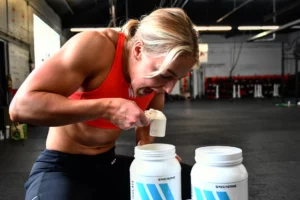If you’ve ever embarked on a new workout routine or pushed your limits during a challenging exercise session, you’re likely familiar with that sensation of stiffness and discomfort in your muscles the following day. This sensation, known as Delayed Onset Muscle Soreness (DOMS), is both a common and often misunderstood aspect of physical fitness. In this comprehensive guide, we’ll explore what DOMS is, whether it’s a sign of muscle growth, its duration, strategies to alleviate its effects, how to prevent it, and whether you should exercise when you’re experiencing DOMS.
What is DOMS?
Delayed Onset Muscle Soreness (DOMS) refers to the muscular discomfort, stiffness, and pain that typically develop 12 to 24 hours after an intense or unfamiliar exercise session and can peak within 48 to 72 hours. DOMS is primarily caused by eccentric muscle contractions, which occur when a muscle lengthens under tension, such as when lowering a weight during a bicep curl or descending stairs.
The exact mechanisms of DOMS are still not entirely clear, but it is believed to involve microtrauma to muscle fibers, inflammation, and the release of substances that sensitize pain receptors. This combination leads to the characteristic soreness and stiffness.
Are DOMS a Sign of Muscle Growth?
While DOMS is often associated with muscle growth, it’s not a direct indicator of muscle growth or hypertrophy. Instead, DOMS reflects the adaptation process that occurs when your muscles are exposed to new or intense training stimuli. This adaptation includes repairing and strengthening the affected muscle fibers, which can contribute to muscle growth over time.
In other words, experiencing DOMS can be a sign that you’ve challenged your muscles, potentially leading to muscle growth as a result of consistent training and proper recovery. However, it’s essential to note that you don’t need to experience DOMS after every workout to see muscle growth or improvements in strength.
How long do doms last?
The duration of DOMS can vary from person to person and depends on several factors, including the individual’s fitness level, the intensity and type of exercise, and the effectiveness of recovery strategies. Generally, DOMS can last anywhere from a few days to a week. Here’s a rough timeline:
Onset (12-24 hours post-exercise): You may start to feel muscle soreness and stiffness, which can become more pronounced over the next day or two.
Peak (48-72 hours post-exercise): This is when DOMS is typically at its worst, and the soreness can make movements uncomfortable.
Resolution (3-7 days post-exercise): The soreness gradually subsides as the body repairs and adapts to the muscle damage.
Keep in mind that DOMS is not an indicator of the effectiveness of your workout. Whether or not you experience DOMS, your muscles can still be benefiting from the training stimulus.
How to help doms
If you find yourself dealing with DOMS, there are several strategies you can employ to alleviate discomfort and promote recovery:
1. Rest and Active Recovery: Allow your body time to recover by getting adequate rest. Gentle, low-impact activities like walking or swimming can help improve blood flow and reduce stiffness without exacerbating muscle damage.
2. Stretching: Gentle stretching exercises can help relieve muscle tension and discomfort associated with DOMS. Focus on dynamic stretches that gently lengthen the muscles without pushing them to their limits.
3. Hydration and Nutrition: Staying well-hydrated and consuming a balanced diet rich in nutrients can aid in the recovery process. Proper nutrition supports muscle repair and reduces inflammation.
4. Over-the-Counter Pain Relief: Non-prescription pain relievers like ibuprofen or aspirin can help manage pain and reduce inflammation. However, consult with a healthcare professional before using any medication.
5. Massage and Foam Rolling: Massage therapy and foam rolling can help relieve muscle tension and improve blood circulation, potentially reducing the severity of DOMS.
6. Epsom Salt Baths: Soaking in a warm bath with Epsom salts may help relax muscles and alleviate soreness.
How to prevent doms
While complete prevention of DOMS is challenging, especially when introducing new exercises or increasing intensity, there are strategies that can help minimize its severity:
1. Gradual Progression: Gradually increase the intensity and duration of your workouts. This allows your muscles to adapt more effectively, reducing the risk of severe DOMS.
2. Warm-Up: Always include a proper warm-up routine before engaging in intense exercise. This increases blood flow to your muscles and prepares them for the workout.
3. Eccentric Loading: If you’re incorporating eccentric exercises into your routine, start with lower resistance and gradually increase it over time.
4. Consistency: Regular, consistent training can help your muscles adapt to stress, reducing the likelihood of severe DOMS with each workout.
5. Proper Hydration and Nutrition: Ensure you’re adequately hydrated and consuming the necessary nutrients to support muscle recovery.
6. Stretching and Cool-Down: Incorporate static stretching and a cool-down routine at the end of your workouts to promote muscle relaxation.
Should you exercise with doms?
One of the most common questions is whether it’s safe to exercise when experiencing DOMS. In most cases, it’s safe to continue working out with mild to moderate DOMS, as long as you adjust your workout intensity and focus on different muscle groups. In fact, light exercise can help alleviate stiffness and promote blood flow, which can aid in recovery.
However, if you’re experiencing severe DOMS that significantly impairs your range of motion or causes intense pain, it’s advisable to allow more time for recovery before engaging in strenuous exercise again. Listen to your body and prioritize recovery when needed to prevent injury and ensure long-term progress.
Conclusion
Delayed Onset Muscle Soreness (DOMS) is a natural part of the adaptation process that occurs when you challenge your muscles. While it may be uncomfortable, it’s not necessarily an indicator of muscle growth. Understanding how to manage and prevent DOMS can help you continue making progress in your fitness journey while minimizing discomfort. Remember that recovery, consistency, and smart training are key elements in achieving your fitness goals, whether DOMS is present or not.






